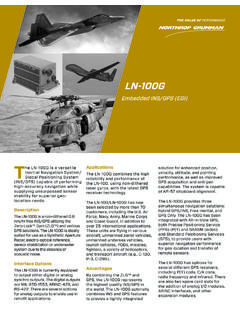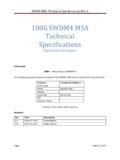Transcription of Short Communication Preliminary assessment of …
1 JOURNAL OFFOOD COMPOSITIONAND ANALYSISJ ournal of Food Composition and Analysis 20 (2007) 430 435 Short CommunicationPreliminary assessment of nutritional value of traditional leafyvegetables in KwaZulu-Natal, South AfricaB. Odhava, , S. Beekrumb, Us Akulaa, H. BaijnathcaDepartment of Biotechnology, ML Sultan Campus, Durban Institute of Technology, Box 1334, Durban 4000, South AfricabDepartment of Food Technology, Steve Biko Campus, Durban Institute of Technology, Box 1334, Durban 4000, South AfricacDepartment of Botany, School of Botany and Zoology, Westville Campus, University of KwaZulu-Natal, South AfricaReceived 17 November 2005; received in revised form 20 April 2006; accepted 27 April 2006 AbstractIn this report, we present Preliminary nutritional data for traditional leafy vegetables collected in Kwa Zulu-Natal, South Africa,including their content of mineral elements (Ca, P, Na, Zn, Mg, Mn and Fe) and antioxidant levels.
2 Twenty vegetables were studied:Amaranthus dubius,Amaranthus hybridus,Amaranthus spinosus,Asystasia gangetica,Bidens pilosa,Centella asiatica,Ceratotheca triloba,Chenopodium album,Cleome monophylla,Cucumis metuliferus,Emex australis,Galinsoga parviflora,Justicia flava,Momordica balsamina,Oxygonum sinuatum,Physalis viscosa,Portulaca oleracea,Senna occidentalis,Solanum nodiflorumandWahlenbergia undulata. The resultsof this study provide evidence that these local traditional vegetables, which do not require formal cultivation, could be importantcontributors to improving the nutritional content of rural and urban people. From this study, it was determined that twelve leafyvegetables, namelyA. dubius,A. gangetica,A. hybridus,A. spinosus,C. metuliferus,C. monophylla,C. triloba,G. parviflora,J. flava,M. balsamina,P.
3 ViscosaandW. undulataprovide mineral concentrations exceeding 1% of plant dry weight and are much higher thantypical mineral concentrations in conventional edible leafy vegetables; they are thus recommended for future commercial levels of antioxidant activity (96%) were noticed inJ. flavaandP. Elsevier Inc. All rights :Nutritional value; Mineral content; Antioxidants; Food supplement; African leafy vegetables1. IntroductionSouth Africa is a country with great cultural diversityand biodiversity, with many people still using a widevariety of plants in their daily lives for food, water, shelter,fuel, medicine and other necessities of life (Van Wyk andGericke, 2000). These plants, often referred to as tradi-tional vegetables, account for 10% of the world s higherplants. However, they are under-utilised in favour ofintroduced non-native vegetables (Rubaihayo, 1992).
4 Theavailability of indigenous vegetables has declined drasti-cally because of excessive cultivation of field crops, whichincludes chemical elimination of wild vegetables andhabitat change. There is also growing ignorance amongyoung people about the existence of these nutritionally richfood decline in the use of indigenous vegetables by manyrural communities has resulted in poor diets and increasedincidence of nutritional deficiency disorders and diseases inmany parts of Africa (Kwapata and Maliro, 1995). TheWorld Health Organization (1982)has reported thatchronic under-nutrition affects some 200 million people,or 42% of the population, in sub-Saharan vegetables represent inexpensive but high-quality nutrition sources for the poor segment of thepopulation, especially where malnutrition is vegetables grow wild and are readily availablein the field as they do not require any formal in Africa have a long history of usingtraditional leafy vegetables to supplement their diets(Chweya and Eyzaguirre, 1999).
5 In addition to someearlier works on this topic (Fox and Norwood Young,ARTICLE IN $ - see front matterr2006 Elsevier Inc. All rights Corresponding author. Tel.: +27 31 3085321; fax: +27 31 (B. Odhav).1982;Tredgold, 1986), several recent publications (Nesam-vuni et al., 2001;Steyn et al., 2001;Jansen van Rensburg etal., 2004) have stressed the nutritional value of traditionaland indigenous leafy vegetables. However, the use oftraditional and indigenous leafy vegetables by local peopleis still a relatively under-researched discipline in SouthAfrica. Knowledge of indigenous plant use needs urgentscientific investigation and documentation before it isirretrievably lost to future generations (Guarino, 1997).The purpose of this study was to conduct a preliminaryassessment of the nutritive value of a range of traditionalleafy vegetables.
6 These data should be a starting point for avaluable knowledge resource, allowing better food selec-tion and consequent improvement in nutritional status ofthe diet of local populations in South Materials and SamplesNutritional analyses (moisture, protein, fat, fibre, ashand minerals) were conducted using the leaves of 20 rawtraditional vegetables (Table 1). Approximately, 10 kg ofleafy material were selected from several plants of eachvariety. Local floristic keys were used for determining thespecies. Data on different species and the Zulu names havebeen sourced from publications on the flora of SouthAfrica (Hutchings, 1996). Voucher specimens are housed inthe Ward Herbarium, University of Kwazulu-Natal,Westville campus, South Africa (seeTable 1,Hutchings,1996).The plants were processed on the same day that theywere harvested.
7 Healthy, green, mature leaves wereremoved from the stems and washed thoroughly withdistilled water until no foreign material remained, and air-dried at room temperature for 2 h. Moisture, protein, fat,fiber and ash analyses were conducted on fresh leaves thatwere ground using a mill. Samples used for mineralanalyses were washed using double deionized waterand dried in an air oven for 6 h at 601C, homogenizedusing a mill. The dried samples were stored in a darkcupboard in capped bottles in desiccators and used within 1month after harvesting. All analyses were conducted induplicate and results were based on fresh weight per 100 gof Chemical analysisFor the chemical analysis, aliquots were made from gof fresh weight from each sample analysed. Two replicateswere made from separate aliquots.
8 Energy was calculated(kcal/100 g fresh weight) using the Atwater system asdescribed by theWorld Health Organization (1985)bymultiplying the values obtained for protein, carbohydratesand fat by , and , respectively; the results areexpressed in , ash, crude protein, fat and dietary fiber wereanalysed by the methods described inAOAC (1990).Moisture was determined using the drying oven method, bydrying a representative 5 g sample in an oven at 1051C for3 h. Ash content was determined by the incineration of asample (4 g) in a muffle furnace at 6001C for 6 h until theash turned protein was estimated by the Kjeldahl protein was calculated by multiplying the evaluatednitrogen by Fat was determined by petroleum etherextraction in a Soxhlet apparatus. A representative 3 g ofsample was extracted for 6 h.
9 Dietary fibre was analysed byan enzymatic gravimetric method using the TecatorARTICLE IN PRESST able 1 Species, habitat and consumption of leafy vegetables in greater Durban area of Kwazulu-Natal, South AfricaScientific nameFamilyEnglish nameZulu nameHabitatTypical consumptionAmaranthus dubiusAmaranthaceaeWild spinachImbuyaCultivated landRegularlyAmaranthus hybridusAmaranthaceaeCockscombImbuyaDist urbed landRegularlyAmaranthus spinosusAmaranthaceaeSpiny pigweedImbuyaRoadside weedRegularlyAsystasia gangeticaAcanthaceaeHunter s spinachIsihoboDisturbed landDuring famineBidens pilosaAsteraceaeBlack jackAmalenjaneDisturbed landRegularlyCentella asiaticaApiaceaeMarsh pennywortIcudwaneSandy shadeDuring famineCeratotheca trilobaPedaliaceaeWild foxgloveUdonqabathwaCultivated landRegularlyChenopodium albumChenopodiaceaeFat henImbikilicaneCultivated landRegularlyCleome monophyllaCapparaceaeSpindle-podIsiwisaC ultivated landRegularlyCucumis metuliferusCucurbitaceaeJelly melonUhufafaRoadside dumpDuring
10 FamineEmex australisPolygonaceaeDevil s thornInkunzaneRoadside weedOccasionallyGalinsoga parvifloraAsteraceaeGallant soldierUshukeyanaCultivated landRegularlyJusticia flavaAcanthaceaeYellow justiciaIpelaGrass landOccasionallyMomordica balsaminaCucurbitaceaeBalsam appleUmkakaDisturbed landRegularlyOxygonum sinuatumPolygonaceaeStars talkUntabaneRoadside weedDuring faminePhysalis viscosaSolanaceaeSticky gooseberryUqadoloDisturbed landDuring faminePortulaca oleraceaPortulacaceaePurslaneMadilikaCul tivated landRegularlySenna occidentalisFabaceaeCoffee sennaIsinyembaneRoadside weedDuring famineSolanum nodiflorumSolanaceaeBlack nightshadeUmsobosoboCultivated landRegularlyWahlenbergia undulataCampanulaceaeGiant bell flowerUshwaqaGrass landDuring famineB. Odhav et al. / Journal of Food Composition and Analysis 20 (2007) 430 435431 Fibertec E System (Foss Tecator, Sweden).





